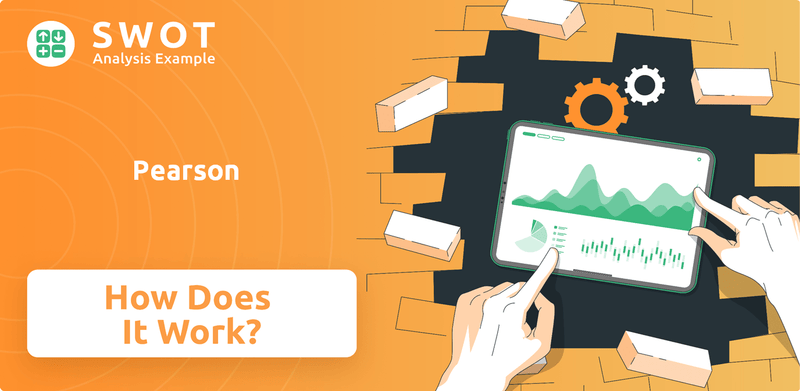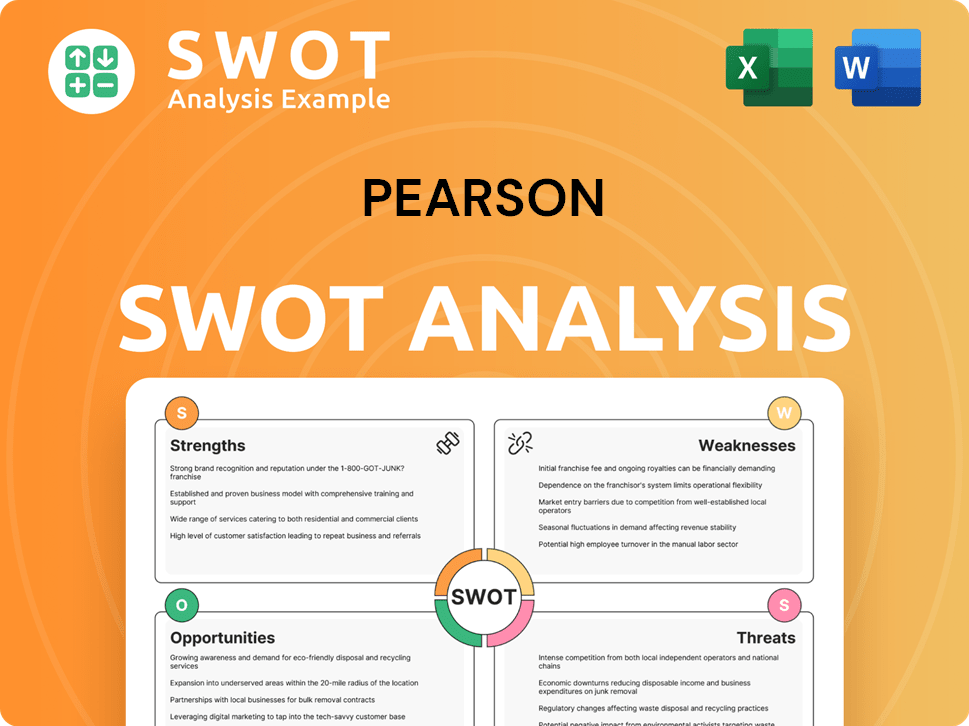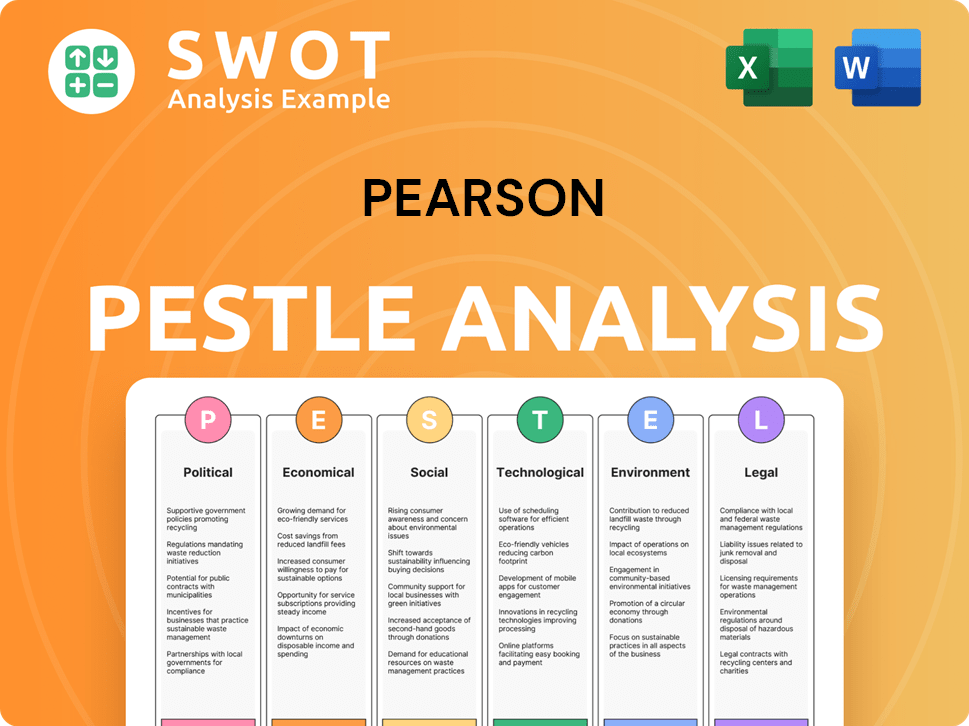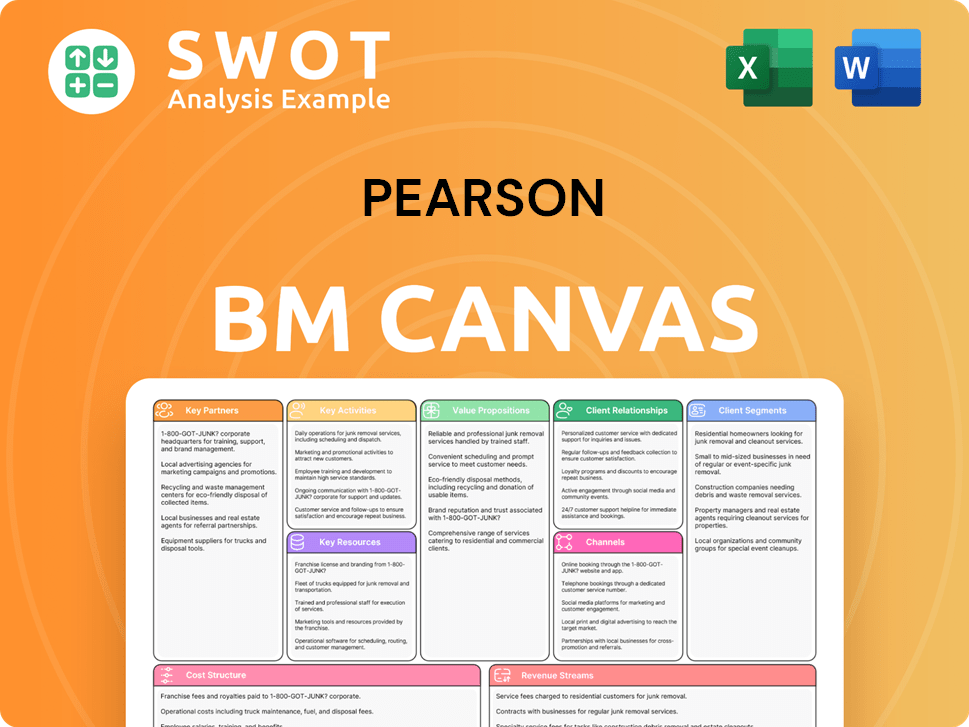Pearson Bundle
How Does Pearson Company Navigate the Global Education Market?
Pearson, a titan in the education sector, reported a robust adjusted operating profit of £573 million in 2023, signaling its financial strength. From foundational learning to professional development, Pearson SWOT Analysis reveals its extensive reach across virtual learning, higher education, and workforce skills. Understanding Pearson's operational framework is key to grasping its market resilience and future growth.

This analysis will explore the intricacies of Pearson Education, examining how it creates value and monetizes its offerings in the dynamic landscape of education publishing. We'll delve into Pearson PLC's strategies for maintaining a competitive edge, including its investments in online learning and digital learning tools. Exploring Pearson's impact on education, including its curriculum development and assessment services, offers insights into its global presence and influence.
What Are the Key Operations Driving Pearson’s Success?
Pearson creates value by providing educational content, assessment tools, and related services. Its primary customers include schools, universities, and professional learners worldwide. Key products include digital courseware, online learning platforms, standardized tests, and certification programs.
The company's operational processes are highly integrated, relying on technology for digital platforms like Pearson+, which offers e-textbooks and study tools. This approach allows for personalized learning experiences and scalable assessment solutions. In 2023, the Assessment & Qualifications division saw sales increase by 5% to £2,109 million, demonstrating the importance of its testing services.
Pearson's supply chain is primarily digital, focusing on content creation, software development, and secure online assessment delivery. Partnerships with educational institutions and government bodies are essential for distribution and market penetration. This integrated approach translates into improved learning outcomes and efficient skill development, setting it apart in the education market.
Pearson offers a wide range of educational resources, including digital courseware and online learning platforms. They also provide standardized tests and certification programs. These products serve schools, universities, and professional learners globally.
Pearson utilizes integrated operational processes, leveraging technology for digital platforms. The focus is on content creation, software development, and the secure delivery of online assessments. Partnerships with educational institutions are also crucial.
The company delivers value through a combination of pedagogical expertise and advanced technology. This approach enables personalized learning experiences and scalable assessment solutions. The focus is on improving learning outcomes and efficient skill development.
Pearson has a strong global presence in the education sector, serving diverse markets. It has a significant impact on education through its products and services. The company's history and evolution are detailed in a Brief History of Pearson.
Pearson's operations involve content creation, digital platform development, and assessment services. These services are delivered globally, supporting various educational needs. The company focuses on innovation in digital learning tools and curriculum development.
- Digital Courseware Development
- Online Learning Platform Management
- Assessment and Certification Services
- Partnerships with Educational Institutions
Pearson SWOT Analysis
- Complete SWOT Breakdown
- Fully Customizable
- Editable in Excel & Word
- Professional Formatting
- Investor-Ready Format

How Does Pearson Make Money?
The Pearson Company generates revenue through a multifaceted approach, reflecting its significant presence in the global education market. Their financial model is built on diverse revenue streams, including assessments, virtual learning, and higher education resources. In 2023, the company's total sales reached £3,703 million, showcasing the scale of its operations and its impact on the education sector.
A key aspect of Pearson Education's financial strategy is its focus on digital transformation and recurring revenue. This shift is evident in the growth of digital products and subscription-based services, such as Pearson+, which provides access to a wide array of educational materials. This move towards digital platforms is designed to improve the predictability of revenue streams and enhance customer lifetime value.
Understanding the revenue streams and monetization strategies of Pearson PLC is crucial for investors and stakeholders. The company's financial performance is directly tied to its ability to adapt to the evolving needs of the education market and to effectively monetize its extensive portfolio of products and services. For more insights, you can also explore the Target Market of Pearson.
Pearson's revenue streams are diversified across various segments. The company's financial performance is influenced by the performance of these key areas.
- Assessment & Qualifications: This segment includes standardized tests, professional certifications, and vocational qualifications. In 2023, it generated £2,109 million in sales.
- Virtual Learning: This segment focuses on online schools and virtual universities, contributing significantly to digital revenue.
- English Language Learning: Revenue comes from English language courses, tests like the PTE Academic, and related learning materials.
- Higher Education: This includes sales of textbooks, digital courseware, and online homework platforms for university students.
- Workforce Skills: This segment provides training and certification for professional development.
Pearson PESTLE Analysis
- Covers All 6 PESTLE Categories
- No Research Needed – Save Hours of Work
- Built by Experts, Trusted by Consultants
- Instant Download, Ready to Use
- 100% Editable, Fully Customizable

Which Strategic Decisions Have Shaped Pearson’s Business Model?
The evolution of the Pearson Company has been shaped by significant milestones and strategic shifts, particularly its move towards digital learning and assessment. A key strategic decision has been the divestiture of non-core assets, such as the sale of its remaining stake in Penguin Random House in 2020, to concentrate on its digital education business. The launch and expansion of products like Pearson+, a subscription service offering e-textbooks and study tools, marks a crucial operational milestone in its digital transformation.
Operational challenges have included adapting to the changing landscape of higher education, especially the decline in traditional textbook sales, and navigating the complexities of global educational markets. Pearson has responded by accelerating its digital offerings and investing in AI-powered learning tools. The company's competitive advantages stem from its strong brand recognition, extensive content library, and global reach. Its ability to provide comprehensive assessment solutions, from K-12 to professional certifications, further solidifies its market position.
Pearson continues to adapt by integrating advanced technologies like AI into its products, aiming to personalize learning and enhance assessment efficacy, thereby maintaining its competitive edge against emerging ed-tech companies. For more insights into the company's growth strategy, consider exploring the Growth Strategy of Pearson.
Key milestones include the shift towards digital learning and assessment, and the divestiture of non-core assets to focus on digital education. The launch of Pearson+ represents a significant operational milestone in its digital transformation. These moves reflect a strategic pivot to adapt to the changing educational landscape.
Strategic moves include the sale of Penguin Random House to concentrate on digital education. Investments in AI-powered learning tools and the expansion of digital offerings are also key. These moves aim to address the decline in traditional textbook sales and to navigate global educational markets.
Pearson's competitive edge comes from its brand recognition, extensive content library, and global reach. Comprehensive assessment solutions and the integration of AI into products further solidify its market position. This allows Pearson to compete effectively against emerging ed-tech companies.
Operational challenges include adapting to the evolving landscape of higher education, particularly the decline in traditional textbook sales, and navigating the complexities of global educational markets. Responding by accelerating digital offerings and investing in AI-powered learning tools is crucial. These challenges require continuous adaptation and innovation.
In recent years, Pearson Education has focused on digital transformation, with digital revenues representing a significant portion of its total revenue. The company has been investing heavily in online learning platforms and digital educational resources to maintain its market position. As of 2024, the company's revenue from digital products continues to grow, reflecting the success of its strategic shift.
- Digital revenue growth has been a key focus, with a reported increase in recent financial reports.
- Investments in AI and personalized learning tools are ongoing, aiming to enhance student outcomes.
- Pearson's global reach and brand recognition provide a competitive advantage in the education publishing market.
- The company's financial performance is closely tied to its ability to adapt to the changing educational landscape and compete with digital-first companies.
Pearson Business Model Canvas
- Complete 9-Block Business Model Canvas
- Effortlessly Communicate Your Business Strategy
- Investor-Ready BMC Format
- 100% Editable and Customizable
- Clear and Structured Layout

How Is Pearson Positioning Itself for Continued Success?
Pearson PLC, a major player in the global education and assessment industry, holds a strong position, particularly in virtual learning, assessment, and English language learning. The company has built a solid reputation over decades, delivering reliable educational content and assessment services. Its brand loyalty is a testament to its long-standing presence in the educational sector.
However, the company faces several challenges. These include evolving regulatory landscapes in education, the rise of agile ed-tech startups, and rapid technological advancements, especially in artificial intelligence. Changes in consumer preferences, such as the growing demand for micro-credentials and personalized learning paths, also pose significant challenges. Understanding the Competitors Landscape of Pearson is crucial for assessing its position.
Pearson is a leading global education company. It has a significant market share in key areas like virtual learning, assessment, and English language learning. The company's extensive experience and strong brand recognition contribute to its industry leadership.
Pearson faces risks from changing educational regulations and the emergence of ed-tech startups. Technological disruption, especially from AI, presents another challenge. Adapting to evolving consumer preferences, such as the demand for personalized learning, is also crucial.
Pearson is focusing on expanding its digital product portfolio and using AI to improve learning outcomes. The company is shifting towards subscription-based models and direct-to-consumer offerings. Pearson aims to solidify its role as a key provider of lifelong learning through innovative digital solutions.
The company emphasizes the expansion of its digital offerings, including Pearson+. Its digital assessment platforms are a key part of its growth strategy. Pearson's future is centered on providing accessible and effective education globally.
Pearson's financial performance is closely tied to its digital transformation and strategic initiatives. The company's focus on digital products and services, such as Pearson+, is designed to drive revenue growth and enhance customer engagement. In recent years, Pearson has been actively managing its portfolio, including the sale of its K12 courseware business in 2019 for $4.6 billion, to focus on higher-growth areas.
- Digital Revenue: Pearson's digital revenue has been steadily increasing, reflecting the success of its digital transformation strategy.
- Subscription Models: The shift towards subscription-based models is a key component of Pearson's long-term revenue strategy, providing recurring revenue streams.
- AI Integration: The company's investment in AI technologies aims to improve learning outcomes and assessment accuracy.
- Global Expansion: Pearson continues to expand its presence in international markets, capitalizing on the growing demand for educational resources worldwide.
Pearson Porter's Five Forces Analysis
- Covers All 5 Competitive Forces in Detail
- Structured for Consultants, Students, and Founders
- 100% Editable in Microsoft Word & Excel
- Instant Digital Download – Use Immediately
- Compatible with Mac & PC – Fully Unlocked

Related Blogs
- What are Mission Vision & Core Values of Pearson Company?
- What is Competitive Landscape of Pearson Company?
- What is Growth Strategy and Future Prospects of Pearson Company?
- What is Sales and Marketing Strategy of Pearson Company?
- What is Brief History of Pearson Company?
- Who Owns Pearson Company?
- What is Customer Demographics and Target Market of Pearson Company?
Disclaimer
All information, articles, and product details provided on this website are for general informational and educational purposes only. We do not claim any ownership over, nor do we intend to infringe upon, any trademarks, copyrights, logos, brand names, or other intellectual property mentioned or depicted on this site. Such intellectual property remains the property of its respective owners, and any references here are made solely for identification or informational purposes, without implying any affiliation, endorsement, or partnership.
We make no representations or warranties, express or implied, regarding the accuracy, completeness, or suitability of any content or products presented. Nothing on this website should be construed as legal, tax, investment, financial, medical, or other professional advice. In addition, no part of this site—including articles or product references—constitutes a solicitation, recommendation, endorsement, advertisement, or offer to buy or sell any securities, franchises, or other financial instruments, particularly in jurisdictions where such activity would be unlawful.
All content is of a general nature and may not address the specific circumstances of any individual or entity. It is not a substitute for professional advice or services. Any actions you take based on the information provided here are strictly at your own risk. You accept full responsibility for any decisions or outcomes arising from your use of this website and agree to release us from any liability in connection with your use of, or reliance upon, the content or products found herein.